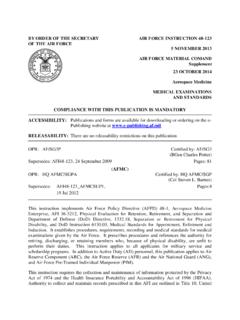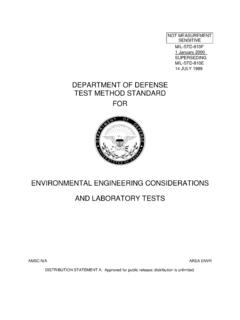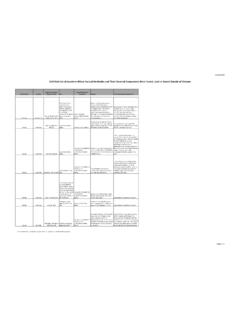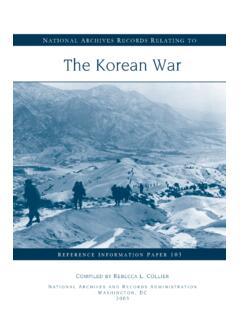Transcription of Engineering Elegant Systems: Theory of Systems ... - NASA
1 NASA/TP 20205003644 Engineering Elegant Systems : Theory of Systems WatsonMarshall Space Flight Center, Huntsville, Mesmer and FarringtonThe University of Alabama in Huntsville, Huntsville, AlabamaJune 2020 National Aeronautics andSpace AdministrationIS02 George C. Marshall Space Flight CenterHuntsville, Alabama 35812 The NASA STI ProfileSince its founding, NASA has been dedicated to the advancement of aeronautics and space science. The NASA Scientific and Technical Information (STI) Program Office plays a key part in helping NASA maintain this important NASA STI Program Office is operated by Langley Research Center, the lead center for NASA s scientific and technical information.
2 The NASA STI Program Office provides access to the NASA STI Database, the largest collection of aeronautical and space science STI in the world. The Program Office is also NASA s institutional mechanism for disseminating the results of its research and development activities. These results are published by NASA in the NASA STI Report Series, which includes the following report types: TECHNICAL PUBLICATION. Reports of completed research or a major significant phase of research that present the results of NASA programs and include extensive data or theoretical analysis.
3 Includes compilations of significant scientific and technical data and information deemed to be of continuing reference value. NASA s counterpart of peer-reviewed formal professional papers but has less stringent limitations on manuscript length and extent of graphic presentations. TECHNICAL MEMORANDUM. Scientific and technical findings that are preliminary or of specialized interest, , quick release reports, working papers, and bibliographies that contain minimal annotation. Does not contain extensive analysis. CONTRACTOR REPORT. Scientific and technical findings by NASA-sponsored contractors and grantees.
4 CONFERENCE PUBLICATION. Collected papers from scientific and technical conferences, symposia, seminars, or other meetings sponsored or cosponsored by NASA. SPECIAL PUBLICATION. Scientific, technical, or historical information from NASA programs, projects, and mission, often concerned with subjects having substantial public interest. TECHNICAL TRANSLATION. English-language translations of foreign scientific and technical material pertinent to NASA s services that complement the STI Program Office s diverse offerings include creating custom thesauri, building customized databases, organizing and publishing research providing more information about the NASA STI Program Office, see the following: Access the NASA STI program home page at < > E-mail your question via the Internet to Phone the NASA STI Help Desk at 757 864 9658 Write to.
5 NASA STI Information Desk Mail Stop 148 NASA Langley Research Center Hampton, VA 23681 2199, USAiNASA/TP 20205003644 Engineering Elegant Systems : Theory of Systems WatsonMarshall Space Flight Center, Huntsville, Mesmer and FarringtonThe University of Alabama in Huntsville, Huntsville, AlabamaJune 2020 National Aeronautics andSpace AdministrationMarshall Space Flight Center Huntsville, Alabama 35812iiAvailable from:NASA STI Information DeskMail Stop 148 NASA Langley Research CenterHampton, VA 23681 2199, USA757 864 9658 This report is also available in electronic form at< >Acknowledgments The progress made in defining Elegant , product-focused Systems Engineering is due to the work by the members of the Systems Engineering Research Consortium.
6 These researchers represent excellence in their field and have impressed with their knowledge, intuition, and research. It is a pleasure working with and discussing with them the challenging questions raised in the discipline of Systems Engineering . Phil Farrington, Paul Collopy, and Bryan Mesmer at The University of Alabama in Huntsville have been outstanding leaders for the university consortium. Present and past members are:North Carolina State University: Jon Stallings, A&M University: Emeka Dunu, State University: Irem Tumer, , Christopher Hoyle, Enterprises, Inc.
7 : John Olds, Institute of Technology: Khaldoun Khashanah Texas A&M University: Richard Malak, , Robert PriceTri-Vector Corporation: Joey Shelton, University of Alabama in Huntsville: Phillip A. Farrington, , Dawn R. Utley, , Laird Burns, , Paul Collopy, , Bryan Mesmer, , P. J. Benfield, , Wes Colley, , Jeff Little, , George J. Nelson, , Dale Thomas, , Sean Owens, Casey EatonThe University of Arkansas: David C. Jensen, The University of Bergen: Erika PalmerThe University of Colorado Colorado Springs: Stephen B. Johnson, Consulting Services: John Doty, University of Michigan: Panos Y.
8 Papalambros, , Melissa Greene, , Arianne Collopy, University of Texas, Arlington: Paul J. Componation, , Susan Ferreira, D. Griffin, , former NASA AdministratorAir force Research Laboratory wright Patterson, Multidisciplinary Science and Technology Center: Jose A. Camberos, , Kirk L. Yerkes, Mason University: John S. Gero, Washington University: Zoe Szajnfarber, , Samantha Marquart Brainard, State University: Christina L. Bloebaum, , Michael C. Dorneich, Solutions: Sherrie Nash, , Robert S. Ryan, Kenny Mitchell, Jeff DownsMultidisciplinary Software Systems Research Corporation (MSSRC): Larry LambeMassachusetts Institute of Technology: Maria C.
9 Yang, University of Science & Technology: David Riggins, Johnson Space Center: Gordon A. Vos, Langley Research Center: Peter A. Parker, , Ken Toro, Anna R. McGowan, , William Cirillo, Marie Ivanco, Kevin D. EarleNASA Marshall Space Flight Center: James G. Andrews, Jeri G. Eckley, Jennifer S. StevensNASA Marshall Space Flight Center, Aetos Corporation: Michael L. Culver TRADEMARKST rade names and trademarks are used in this report for identification only. This usage does not constitute an official endorsement, either expressed or implied, by the National Aeronautics and Space The NASA Systems Engineering Research Consortium was founded to investigate the engi-neering and mathematical basis of Systems Engineering .
10 The Consortium brought together some tremendous Systems Engineering researchers from across the country to contribute their investigative work to an integrated body of knowledge. I have had the great privilege of working with the research-ers, discussing their research, and bringing together their tremendous intellectual understandings to define the basis of Systems Engineering . In the summer of 2010, as NASA was transitioning from the cancellation of the Constella-tion program to the Exploration Systems Framework, NASA Marshall Space Flight Center (MSFC) Engineering Directorate Associate Director, Garry Lyles, asked my thoughts on Systems engineer-ing.

















